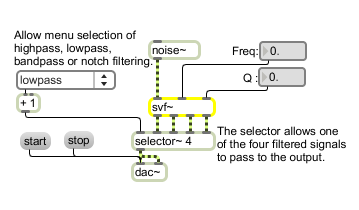Examples

Four filter outputs are simultaneously available from the svf~ object
State-variable filter with simultaneous outputs
| Name | Type | Opt | Description |
|---|---|---|---|
| initial-gain center-frequency and Q | float | opt | Numbers set the initial gain, center frequency, and Q. The default values are 0 for gain, 0 for center frequency, and 0.01 for Q. |
| Hz | symbol | opt | Sets the frequency input mode to Hz (the default mode - hence this is the same as providing no mode argument). |
| linear | symbol | opt | Sets the frequency input mode to linear (0 -1). |
| radians | symbol | opt | Sets the frequency input mode to radians (0 -1). |
| int | center-frequency/Q [int] |
Converted to . |
| float | center-frequency/Q [float] |
In middle and right inlets: A can be sent in the two right inlets to change the center frequency and Q of the filter. By default, the center frequency is expressed in Hz, where the allowable range is from 0 to one fourth of the current sampling rate. For convenience, svf~ has two additional input modes that use the more conventional input range, 0 - 1. (see the and messages). If a signal is connected to one of the inlets, a number received in that inlet is ignored. The values are sampled once every signal vector. |
| Hz | In either inlet: Sets the frequency input mode to Hz (the default). | |
| clear | Clears the object's sample-memory in case of a blow-up. | |
| linear | In any inlet: Sets the frequency input mode to linear (0 - 1). Linear mode is simply a scaled version of the standard Hz mode, except that values in the 0-1 range traverse the full frequency range. | |
| radians | In any inlet: Sets the frequency input mode to radians (0 - 1). Radians mode lets you set the center frequency directly -- while the input has the same range (0-1), the output has a curved frequency response that is closer to the exponential pitch scale of the human ear. | |
| signal | In left inlet: Signal to be filtered. In middle inlet: Sets the filter center frequency in Hz. In right inlet: Sets the bandpass filter "Q" - roughly, the sharpness of the filter - where Q is defined as the filter bandwidth divided by the center frequency. Useful Q values are typically between 0.01 and 500. |
